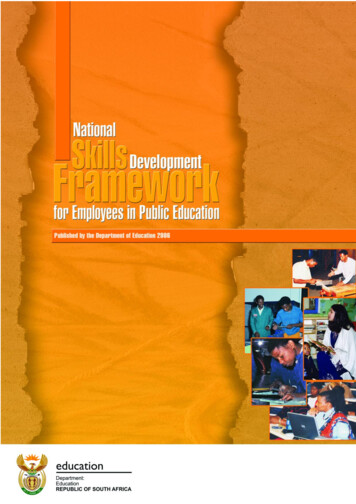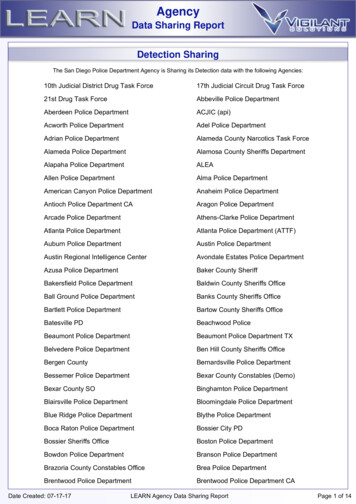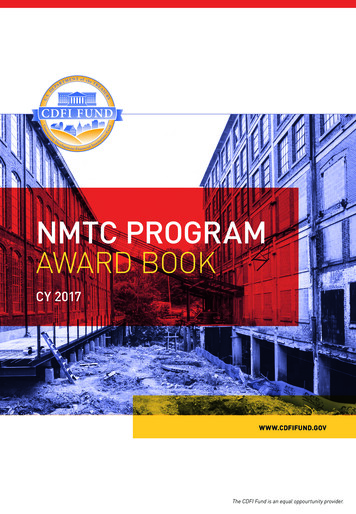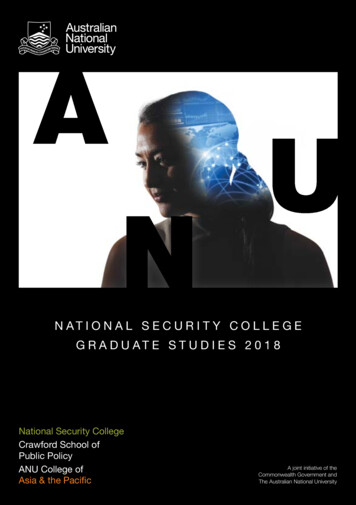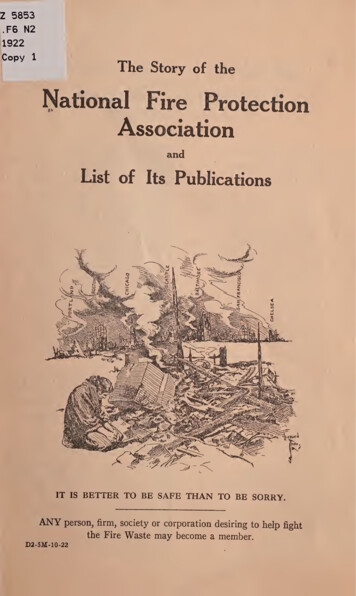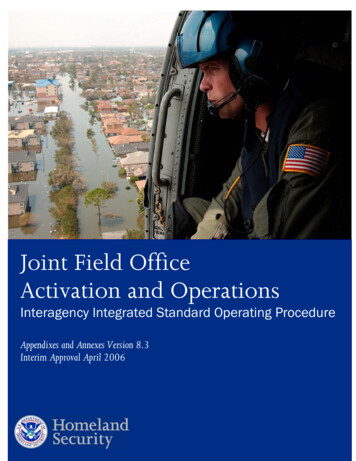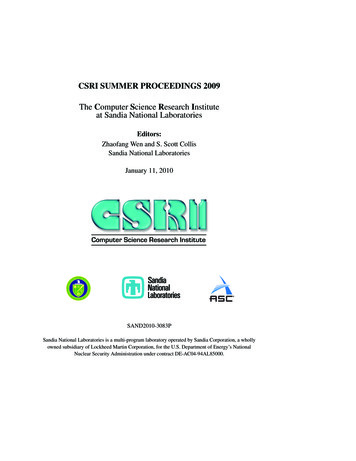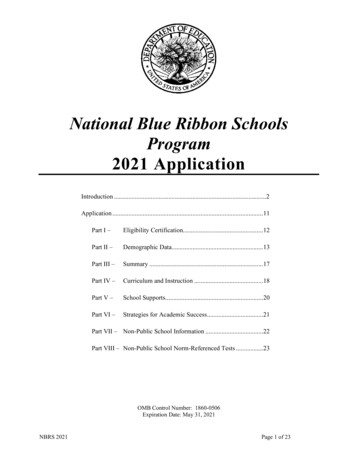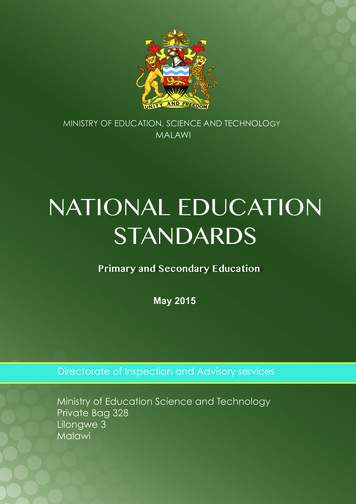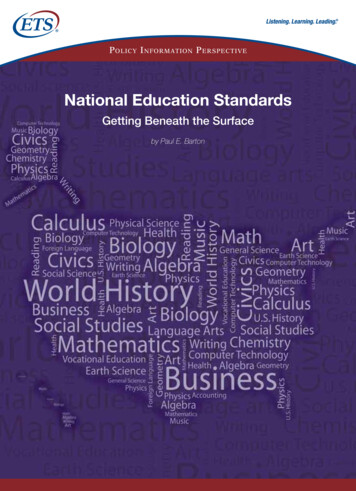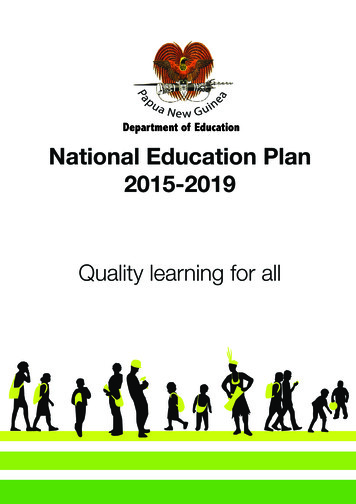
Transcription
eaPapua N e w G uinDepartment of EducationNational Education Plan2015-2019Quality learning for all
National Education Plan2015 - 2019Quality learning for all
AcknowledgmentsIt is essential to demonstrate our appreciation of those whose tireless efforts helped to formulate the NationalEducation Plan 2015–19. Their contributions are highly commendable.It is not possible to thank individually everyone who has contributed to the development of the plan. The listincludes many individuals in the national Department of Education (DoE), other government departments, churchagencies, development partners and provincial education officers; we acknowledge all their contributions.However, we particularly acknowledge acting Secretary for Education Dr. Uke Kombra, PhD, the DoE planning teamincluding Joseph Logha, Maxton Essy, John Kawage, Sabati Mero, Peter Lagia, Kaminiel Irima, Raphael Pavuo, JoeDau and former Secretary for Education Dr. Michael F. Tapo EdD.We also acknowledge the support of the Australian government through its Education Capacity DevelopmentFacility advisory support, Voluntary Service Overseas and UNICEF.All rights reserved. No part of this publication may be reproduced, distributed, or transmitted in any form or by anymeans, including photocopying, recording, or other electronic or mechanical methods, without the prior writtenpermission of the publisher, except for the case of brief quotations in reviews and certain other non-commercialuses permitted by copyright law. For permission requests, write to the publisher at the address below.Department of EducationFincorp HausPO Box 446WaiganiPort MoresbyNational Capital DistrictPapua New Guineawww.education.gov.pgDesign by Amandine Goineau & David GeregaPrinted in Papua New Guinea byFirst Printing, 2016ISBN 978-9980-89-097-9
ContentsAbbreviations and acronyms4Figures and tables6Message from the Minister for Education8Message from the Secretary for Education9Executive summary10Section onePapua New Guinea context13Section twoEducation in Papua New Guinea17Section threePlanning framework29- An overview of future development ofeducation in PNG32- Universal Education in PNG33Section fourThe plan35Section fiveMonitoring and evaluation53Section sixProjections and costings67Section sevenAnnexes73Annex AAdditional data74Annex BEnrollment projections for 2015–2478Annex CProposal for school system restructure reform79Reference material81Section eight
Abbreviations and acronymsADAdministration Division, NDoEALESCOPNG government’s human resource and payroll systemAOFPAnnual Operational Financial PlanBOGBoard Of GovernorsBOMBoard Of ManagementCDDCurriculum Development Division, NDoECEAChurch education agencyDPLGADepartment of Provincial and Local Government AffairsDSGDistrict Support GrantECCEEarly-childhood care and educationEFAEducation For AllE-LDE-Learning Division, NDoEEMISEducation Management Information SystemFDFinance Division, NDoEFODEFlexible open and distance learningGCDGuidance and Counselling Division, NDoEGDPGross domestic productGERGross enrolment ratioGESGeneral Education Services Division, NDoEGoPNGGovernment of Papua New GuineaHIV/AIDSHuman immunodeficiency virus/acquired immune deficiency syndromeHRODHuman Resources and Organisational Development Division, NDoEIAInternal Audit Division, NDoEICTInformation and communications technologyICTDInformation and Communications Technology Division, NDoEIFMSIntegrated Financial Management SystemKmKina millionLLGLocal-Level GovernmentM&EMonitoring and evaluationMCUMedia and Communications Unit, NDoEMoEMinistry of EducationMSDMeasurement Services Division, NDoENDoENational Department of EducationNEPNational Education PlanNERNet enrolment ratioNESNational education system4 I Quality learning for all
NGONon-governmental organisationNLASNational Literacy Awareness Secretariat, OLANQSSFNational Quality School Standards FrameworkNSLCFNational School Leadership Competency FrameworkNTCFNational Teachers’ Competency FrameworkOLAOffice of Libraries and ArchivesOOSCIOut-Of-School Children InitiativePaBERPacific Benchmarking for Education ResultsP&CParents and citizensPARIPapua New Guinea Accessibility Remote IndexPayDPayroll Division, NDoEPILNAPacific Islands Literacy and Numeracy AssessmentPISAProgram for International Student AssessmentPNGPapua New GuineaPPDPolicy and Planning Division, NDoEPQEPParents for Quality Education ProgramProDProcurement Division, NDoEREDResearch and Evaluation Division, NDoESBCStandards-Based CurriculumSBEStandards-Based EducationSDStandards Division, NDoESERCSpecial Education Resource CentreSGStandards and Guidance Division, NDoESLIPSchool Learning Improvement PlanSOStandards OfficerTEDTeacher Education Division, NDoETFFTuition Fee FreeTIMSSTrends in International Mathematics and Science StudyTSCTeaching Service CommissionTVETTechnical and vocational education and trainingTVETDTechnical and Vocational Education and Training Divisions, NDoEWaSHWater sanitation and hygieneNational Education Plan I 5
Figures and tablesFigure 1The regions and provinces of Papua New Guinea14Figure 2Total enrolment growth, 2004–1420Figure 3Enrolment growth, by sector, 2004–1421Figure 4Grade 8 to Grade 9 transition rate, by gender, 2004–1421Figure 5Total government funding of education and enrolment, indexed to 2004 100, 2004–1323Figure 6Total government funding of education, by major costs, 2004–13 (Km)24Figure 7Education system, 201525Figure 8Gender of enrolled students, by sector, 201427Figure 9The National Education Plan connections in planning30Figure 10NEP 2015–19 logic framework36Figure 11NEP outputs55Figure 12NEP outcomes62Figure 13Student population, by grade, gender and over-age percentage, 201475Table 1Number of schools operating, by management, 201425Table 2Number of students enrolled, by grade, 201426Table 3Teacher numbers and teacher-pupil ratio, by grade, 201426Table 4Transition rate, 201427Table 5Long-term school building targets, in line with Vision 205039Table 6Projected student enrolment, 2015–1968Table 7Financial projections, 2015 –1969Table 8Revenue projections, by source, 2015–1971Table 9Qualifications of teachers, by sector and gender, minimum required highlighted(% of total qualifications)74Table 10Number of operating schools, by province and sector, 201475Table 11Student:teacher ratio and average number of teachers per school, by provinceand sector, 201475Table 12Student enrolment, by province and gender, 201476Table 13Districts without vocational centres, 201476Table 14Toilets, by sector, construction and gender, 201377Table 15Students with special needs, by grade, 201377Table 16Students with special needs registered with Special Education Resource Centre(SERC), by grade, 201377Table 17Projected student enrolment, 2015–2478Table 18:Current system to Neew sytem796 I Quality learning for all
Messagefrom the Minister for EducationIn this NEP I am delighted to announce the beginning of a well overdue initiative of 13 years ofUniversal Education for all students. This is a very exciting phase of development for our educationsystem, building on the success of Universal Basic Education strategies. It will see PNG leadingthe way towards the achieving the Global 2030 goals of education. Every child in this country hasthe right to a relevant and quality education and this plan will lead the way.Under Universal Education every child will have a quality education, with teacher’s qualificationsupgraded and a National Curriculum Framework guiding 13 years of education. There will beQuality Standards in place for learning, schools, teachers and principals. I pledge that we will makesure those standards are met and upheld across the country.Universal Education will commence with a preparatory grade to build the foundations of literacyand numeracy. Students will progress through their primary education with grade 7 and 8 students,remaining in a primary school setting, having specialist English, mathematics and science teachersand learning skills such as critical thinking and problem solving. All Grade 9 to 12s will havechoice of subjects to meet their academic, vocational and life needs.The government’s goal is to become a Smart, Wise, Fair, Healthy and Happy Society by 2050. Toachieve this we need a quality, relevant and accessible education for every child, regardless of hisor her circumstance. To achieve this we need to include learning of social and community valuesas well as 21st century skills such as problem, solving, self direction and critical thinking. With thisapproach to education PNG’s citizens will be better equipped to make a positive contribution toour community while being able to stand tall in the international arena.This NEP provides the road map for implementing the government’s commitment to providingeducation and training in the technical and vocational skills that are an essential requirement for asuccessful nation. This plan is ambitious. It confirms the serious and determined commitment wehave to establishing a first class education system in PNG. It shows clearly how well consideredstrategies can contribute to the ultimate goal of quality learning for all.The national government will lead the way and work with all levels of government and educationalinstitutions. It will also continue to provide substantial funding for education. The NEP dependson collaboration at all levels. It sets out clear strategies and responsibilities, for the NationalDepartment of Education and for provincial and lower-level governments.Our fellow citizens have a right to expect us all to work together to achieve quality learning for all.The country’s foundation for a better future is Education and our commitment is to recognizeit as a right will empower citizens to be smart, wiser, fair, healthy and happy.Honourable Nick Kuman, B.ApSci.UWSyd, MBE, MPMinister for Education8 I Quality learning for all
Message from the Secretary for EducationThis strategic plan has been produced by the Department of Education, but it is not a plan just forthe public servants working in the department’s headquarters. It is a plan for everyone who hasresponsibilities for education in Papua New Guinea.The plan has been produced after consultations with people and organisations around the countryand therefore reflects the reality on the ground. The strategies in the plan take account of theresources and capacities in all parts of the education system and are therefore strategies that weknow we can achieve. The government’s commitment to education means that we have no excusefor any failure to produce those deliverables.Partners in education will work together to implement strategies to ensure that we achieve thethree outcomes detailed in the NEP: all children and youths having access to a complete qualityeducation; all students achieving learning standards and retention benchmarks; and educationsystems operating in a timely, proactive and coordinated manner. The three outcomes will resultin quality learning for all. The plan recognises that quality education and training are essential foreveryone.This plan proudly presents Universal Education, where all students can progress through 13 yearsof relevant learning. Each six year old child will begin his or her schooling learning the foundationsof education with an early childhood education approach, progress through primary years to asecondary education with relevant learning choices to include academic, work and life skills.The department will also work closely with and support its partners throughout the country,including the Teaching Service Commission, the Office of Libraries and Archives, provincial andother governments, teachers, schools, parents and communities. All of us must work together forthe good of the children and youths of Papua New Guinea.We must measure our progress towards the quality learning goal and we must all be held to accountfor our work. An important part of the plan is therefore the monitoring and evaluation system thatwe will run in parallel with the strategies in the plan. Effective monitoring and evaluation will let ussee what is working and what is not and will let us make corrections during the life of the NEP, aswell as informing our system decision-making.I urge you to work with us to make the plan a success by doing your part to implement strategiessuccessfully, for the benefit of everyone in our country.Dr. Uke Kombra, PhDSecretary for EducationNational Education Plan I 9
Executive summaryDespite tangible progress in education over the past decade, much more remains to be done to improve access,retention, quality, equity and management to address remaining challenges in education.The NEP 2015–19 is designed to give everyone in Papua New Guinea, regardless of their ability, gender orsocio - economic background, an opportunity to be educated and to transform their lives, using an holistic, inclusiveand integrated approach.There have been many changes in the country’s education system and policies since independence 40 years ago.This plan is designed to build on past successes and experience and begin a system providing 13 years UniversalEducation. High-quality, relevant education and training for all.This plan is different to previous plans in a number of ways. Firstly it outlines all interventions needed that togetherwill achieve Universal Education in PNG. This National Education Plan intends to have PNG leading the way by takingthe bold step towards13 years of Universal Education for every student in the country. Universal Education can beachieved in our country with a coordinated approach supported by strong political drive, quality leadership and arelentlessness to achieve its intent.Contained in this plan is the outline of the radical and comprehensive overhaul of many aspects of the educationsystem proposed to give all children the opportunity to enter school at the age of six and receive a relevant educationfor 13 years, until they reach Grade 12 or the equivalent (18 years of age).The NEP 2015-19 is based on a logic framework, so that the plan itself can be monitored and progressed measured.Every province will play a critical role in implementing the plan and using the same framework, they can compare theirprogress at provincial and national level. This approach means DoE is transparent in its approach and accountableto achieve its targets.The six focus areas are: access and equityAll Papua New Guineans will have access to 13 years of education and training. This should be irrespective of economiccircumstances, location and gender and in a positive learning environment that is safe and hygienic. teachers and teachingWell-trained and qualified teachers will be in place to meet student demand. There should be enough resources,support and accommodation at schools for quality teaching and learning. learningRelevant curriculum will be in place for learners to acquire skills and knowledge for a happy and healthy life. A learningassessment system will focus on improving learning. alternate pathwaysStudents will be able to choose easy-to-access pathways to attain technical, work and life skills, and move betweenthose and more traditional education sectors. local managementSchools will have strong educational leadership and be well managed, to achieve maximum student learning whilebeing accountable to the community. Parents and wider communities will be encouraged to actively support schools. system strengtheningNational, provincial and district systems will improve their planning and operations to support schools to focus onimproving student learning. Technology will be used to improve systems and access to information.For each focus area there are clear strategies that will be turned into activities in the operational plans to be writtenby the Department of Education and other education partners around the country. The strategies have associateddeliverables which will result in clear outputs by 2019, such as more infrastructure and teachers in place andeasier access to alternate pathways for the development of work and life skills. All are underpinned by a focus on10 I Quality learning for all
improving quality and are intended to create improved outcomes for girls.The outputs are designed to produce three outcomes, related to access to education, achievement of learning andeffective and efficient operation of the education system. Combined achievement of those outcomes will result inattainment of the ultimate goal; quality learning for all.All the strategies are achievable and affordable, supported and take account of existing and potential governmentpolicies and initiatives.The NEP outlines the responsibilities of different organisations, including divisions of the Department of Education,for the strategies, as well as the associated time lines. It makes it clear that parents and local communities haveimportant roles to play.To ensure that the strategies are carried out and to measure their success, the NEP includes a transparent monitoringand evaluation system based on international best-practice. There are realistic and achievable targets, to be measuredagainst the situation at the start of the NEP’s five-year period. The measurements will be based on simple indicatorsand will be verified using the systems indicated, such as the department’s Education Management InformationSystem.It will be important to be flexible over the lifetime of the plan. Therefore, strategies may be modified in the light ofexperience; including taking advantage of better-than-expected progress towards particular targets and outputs.Overall, the NEP is also consistent with: The Papua New Guinea National Goals and Directive Principles International goals, in particular the Sustainable Development Goals and the Education For All goals Recent government reforms to improve education service delivery Community input from provincial consultations Stakeholder inputsThe NEP presents a clear and easily-understood path towards quality learning for all.National Education Plan I 11
Section onePapua New Guinea contextQuality learning for all I 13
Section one – Papua New Guinea contextPapua New Guinea is one of the world’s most ethnically diverse countries. Its population of an estimated 7.3 millionspeaks more than 850 indigenous languages and is spread across some of the world’s most difficult terrain. Anestimated 88 per cent of the population lives in rural areas, often isolated with poor communications. The overallliteracy rate (literate in at least one language) is 68 per cent, an increase of 12 percentage points since the 2000Census. Tok Pisin shows the highest literacy rate of 57 per cent, followed by local languages (Tok Ples) at 56 per centand English at 49 per cent (PNG Census, 2011).Papua New Guinea comprises the eastern half of New Guinea island and nearby islands and is the largest country(461,690 km²) in the Pacific region. It has more than 600 islands and the mainland is mostly covered by tropical rainforest and has large mountain ranges. Transport links are poor or non-existent.Demographically, Papua New Guinea is a young country; 76 per cent of the population is under 35 years old and 35per cent is under 15. Annual population growth is 3.1 per cent, with the population expected to reach 9 million by theend of the decade.Papua New Guinea gained independence from Australia in 1975 and is a constitutional monarchy with a parliamentarydemocracy. Many government functions are devolved to the country’s 22 provinces and to lower levels.The country is divided into four regions – Highlands, Momase, New Guinea Islands and Southern. The capital is PortMoresby, with a population of about 400,000. The main regional centres are Goroka and Mt. Hagen in the denselypopulated Highlands Region, the commercial port of Lae in the Momase region, and Kokopo/Rabaul in the NewGuinea Islands region (United Nations Devlopment Programme, 2014).Figure 1: The regions and provinces of Papua New GuineaPapua New GuineaLorengauMomaseVanimoManusKaviengNew IrelandWest Sepik(Sandaun)WewakEast SepikRabaulMadang12MadangWabagMt. Hagen4BanzTariMendi5Highlands3KimbeKundiawa Goroka6Morobe7EastNew BritainArawaWestNew BritainLaeGulfWestern(Fly River)New Guinea IslandsKeremaDaruPopondettaNationalCapital DistrictPort Moresby1 Hela2 Enga3 Western Highlands4 Jiwaka5 Southern Highlands6 Chimbu (Simbu)7 Eastern Highlands14 I Quality learning for allNorthern(Oro)Milne BayCentralHighlandsAlotauSouthernBougainville
Papua New Guinea is a lower- to middle-income country with a GDP of US 15.4 billion and a per capita incomeof US 2,104.9 (World Bank, 2013). It has a formal, corporate sector and a large informal sector where subsistencefarming accounts for the bulk of economic activity. The formal sector provides a narrow employment base, consistingof mineral production, some manufacturing, the public sector, and services including finance, construction,transportation and utilities. It is estimated that 75 per cent of households depend on subsistence agriculture, with 40per cent of the population living on less than 1 a day (United Nations Development Programme, 2014).Papua New Guinea is rich in natural resources (forests, fish and minerals) and has vast ecosystems hosting a uniquebiodiversity. Oil and gas, mining and construction activities have allowed the economy to expand strongly in recentyears.The economy was projected to grow by 15.5 per cent in 2015, compared with 8.4 per cent in 2014, driven mainly bya first full calendar year of liquefied natural gas production in the country and overall oil and gas growth of 156 percent. However, the oil and gas sector was expected to return to negative growth by 2019 as the oil fields are depleted.The mining and quarrying sector was expected to grow by 12.0 per cent in 2015, but then slow down as the Ok Tedimine undergoes life extension work, before rebounding towards 2019 as increased mine production begins.Growth in the non-mining sectors was expected to increase from 1.4 per cent in 2014 to 4 per cent in 2015, partlyreflecting preparations for the 2015 Pacific Games and the 2018 Asia Pacific Economic Co-operation meeting.Agriculture was projected to expand by 3.6 per cent in 2015, based on improvements expected in coffee and cocoagrowing and the elimination of copra oil production bottlenecks. Manufacturing, wholesaling and retailing andtransport, storage and communications were expected to continue to grow in 2015, with electricity, gas and waterslowing down.From 2016 to 2019 the economy was expected to adjust to traditional drivers led by agriculture, fishing and forestryand supported by expansion of the private sector. Inflation was expected to decrease to 5.5 per cent in 2015 from 5.9per cent in 2014 and then to stabilise at about 5.0 per cent until 2019.National Education Plan I 15
Section twoEducation in Papua New GuineaQuality learning for all I 17
Section two – Education in Papua New GuineaUnder the Education Act (1983, consolidated 1995, p9), administration of the national education system is vested inthe following authorities: The Minister for Education The National Education Board (NEB) The departmental head (Secretary for Education) The Teaching Service Commission (TSC) Provincial governments Education boards Local-Level Governments (LLGs) Education agencies The governing bodies of schoolsMinister for EducationThe minister is the political head responsible for the overall management of education through the Ministry ofEducation, which comprises the National Department of Education (NDoE), the Office of Libraries and Archives (OLA)and the Teaching Service Commission (TSC).National Department of EducationUnder the Organic Law on Provincial Governments and Local-Level Governments, the NDoE determinesnational policies and standards and supports their implementation by the provinces with services such asplanning, research, training and staff development.The NDoE is responsible for: teacher education, inspection and registration; the national curriculum;curriculum materials; and examinations. It is also responsible for national institutions, namely teachers’colleges, technical colleges, national high schools, special education resource centers, flexible open anddistance education (FODE) centres and schools in the National Capital District.Office of Libraries and ArchivesThe Office of Libraries and Archives (OLA) comprises three divisions: the National Library Service of PapuaNew Guinea; the National Archives; and Corporate Services. Its major role is to co-ordinate the planningand development of libraries and archives throughout the country. The National Library Service’s primaryobjective is to preserve all documents on Papua New Guinea life and society in the national collection for allPapua New Guineans to enjoy and learn from.Teaching Service CommissionThe Teaching Service Commission (TSC), established by an Act of Parliament, acts as the agent of the statefor the employment of teachers. It oversees teachers’ terms and conditions of service, salaries, allowancesand welfare. It supports the rights of teachers.The National Education BoardThe NEB is the highest education decision-making body in Papua New Guinea, overseeing the development andfunctioning of the education system and the implementation of the NEP. It advises the minister, in consultation withprovincial governments, the TSC and education boards and agencies. The Secretary for Education, as head of theeducation department, is the statutory chairman of the NEB.Departmental headThe head of the Department of Education is the Secretary for Education. The Secretary also chairs the NationalEducation Board.18 I Quality learning for all
Provincial governmentsThrough the provincial and district administrations and provincial education boards, the provinces haveresponsibility for establishing, building and maintaining schools. The provinces deploy teachers and employprovincial and district education officers.A provincial education subsidy in the form of Education Function Grants must be spent on operating costs andmaintenance, and at least half must be spent on the districts’ minimum priority activities. Communities, throughschools’ governing bodies, share responsibility for infrastructure, including school buildings, teachers’ houses andancillary facilities.Education boardsThe Provincial Education Board (PEB) is the highest education decision-making body in a province. Most provincialboards are headed by a chairman, who is the Provincial Education Adviser. Powers and functions of the PEBs varyfrom province to province depending on the powers devolved to them and subject to the capacity of the province.District Education Boards are an integral part of the administration of education in the districts. Members arestakeholders within the districts. The powers and functions of the district boards vary from province to provincedepending on the powers devolved to them. The National Education Board can veto board decisions.Local-Level GovernmentsLocal-Level Government is the third level of government. It plays a minimal role in education but its responsibilitiesinclude the funding and maintenance of elementary and primary schools and helping districts to develop districteducation plans consistent with provincial education plans.Education agenciesEducation agencies are key partners in the delivery of education services in Papua New Guinea. They include faithbased and private agencies with well-established networks of schools in the provinces in all education sectors.The agencies may have varied student entry criteria and teacher terms and conditions, but they are entitledto school subsidies from the government. Teachers are paid by the government, except those employed byinternational education agencies.Governing boards of member schoolsGoverning boards are Boards of Management (BOMs) in elementary and primary schools and Boards of Governors(BOGs) in secondary and other post-primary schools. They are the schools’ highest decision-making bodies andhave financial and management powers. They also have disciplinary powers but their decisions can be vetoed bythe National Education BoardNational Education Plan I 19
Progress in educationDuring Australia’s administration, Papua New Guinea adopted that country’s education system. Since independencein 1975, the system has undergone major reforms and has grown to more than 11,000 institutions and around 1.9million pupils who are taught by almost 52,000 teachers in the elementary, primary and post-primary sectors (EMIS,NDoE, 2014).Figure 2: Total enrollment growth, urce: EMIS, NDoE, 2015An important step towards reforming education was the development of a new philosophy of education outlined inthe Matane Report (1986), based on ‘integral human development’. This philosophy has permeated and influencededucation planning, policy development and practices ever since.The last 10 years have seen major programs and policies to improve access, retention, quality, equity and educationmanagement, although there has not always been measured and sustained progress. Corresponding reforms ingovernance were introduced and critical financial resources provided, to enable efficient and effective delivery ofbasic education, resulting in improved education access, retention and quality.The first National Education Plan, the NEP 1995–2004, produced a restructuring of the education system and a reformof the curriculum. The NEP 2005–14 aimed to increase access and participation at all levels of education, supportingUNESCO’s Education For All (EFA) goal of universal primary education. It
6 I Quality learning for all Figures and tables Figure 1 The regions and provinces of Papua New Guinea 14 Figure 2 Total enrolment growth, 2004-14 20 Figure 3 Enrolment growth, by sector, 2004-14 21 Figure 4 Grade 8 to Grade 9 transition rate, by gender, 2004-14 21 Figure 5 Total government funding of education and enrolment, indexed to 2004 100, 2004-13 23
